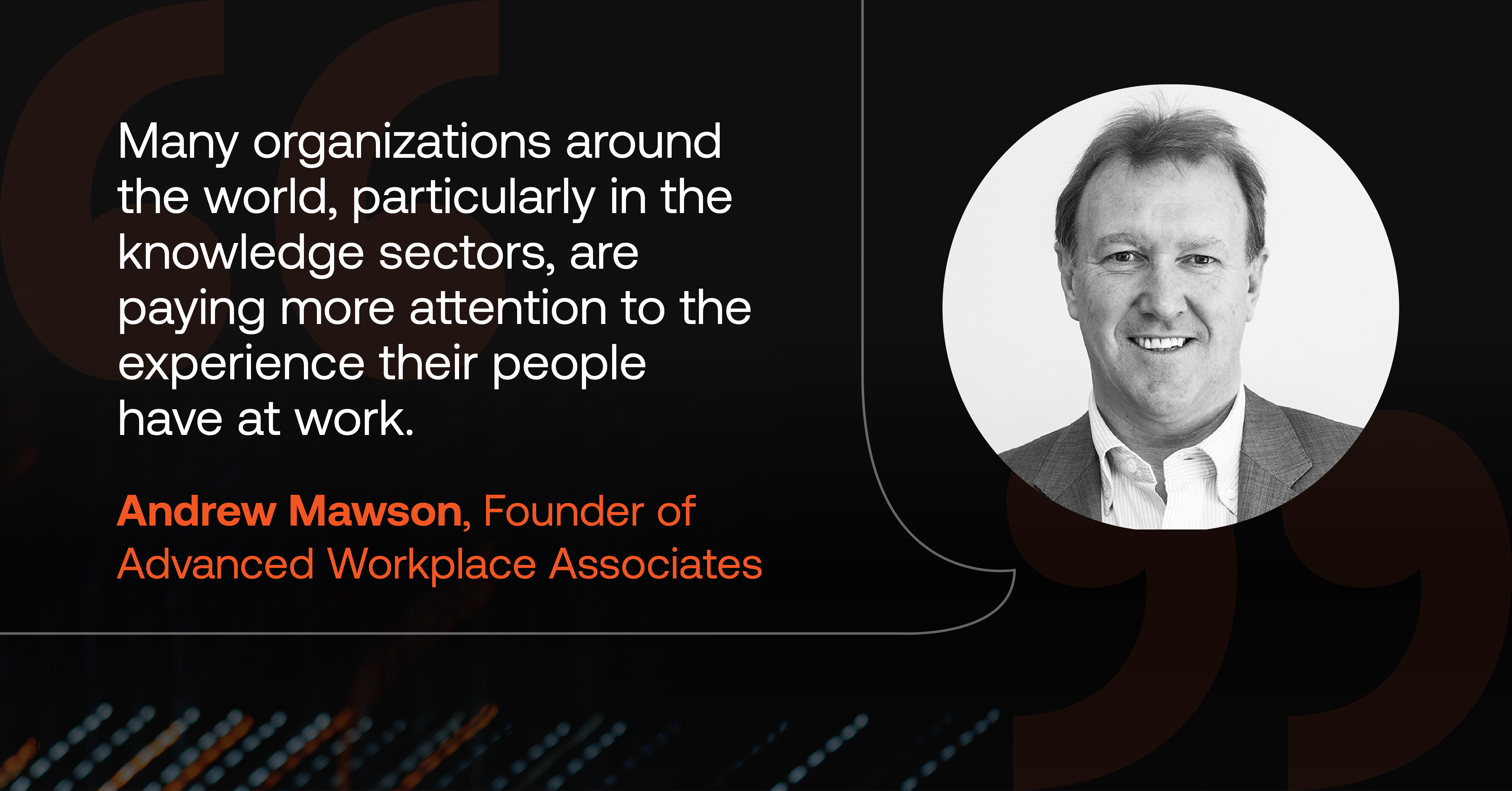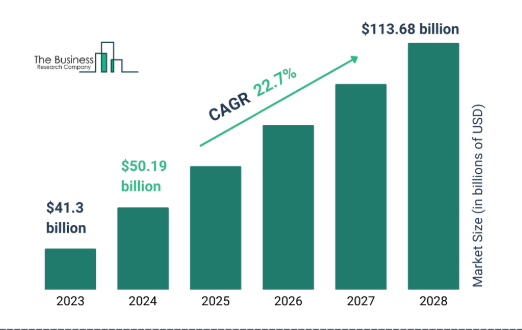“The war for key talent continues to rage across sectors.”
This quote, from workplace expert Andrew Mawson, sums up the challenge of attracting and retaining top talent that companies face right now.
The digital workplace experience they can offer is quickly becoming a decisive factor in standing out as an employer of choice.
“Many organizations around the world, particularly in the knowledge sectors, are paying more attention to the experience their people have at work,” says Mawson in a recent Forbes article. “(This is key) to securing the loyalty of their existing workers and selling their company to new recruits.”

The ongoing digital transformation of the business world means that digital workplace experience (DWE) is an obvious area for companies to target when faced with improving skilled staff retention.
But what exactly is the digital workplace and how can it impact the employee experience in such a way that marks a company out as one top talent wants to work for?
Read on to discover clear examples of effective DWE and how leaders can use it to win the loyalty of the best people in the market.
Contents
- What is digital workplace experience?
- What is an example of a digital workplace? The key features
- How to measure a company’s digital workplace experience
- How to improve the digital employee experience
FlexxClient provides your employees with technology experiences that deliver measurable results to your business. Book a demo to find out how we can future-proof your organization’s workforce.
What is a digital workplace experience?
An excellent digital workplace experience is one of the main drivers behind modern business success.
So much so that The Business Research Company forecasts a 126% increase in digital workplace market size by 2028.
The rise of the digital workplace market size (2023-28)

Source: The Business Research Company
Yet many people talk about this topic without fully understanding what it is: a digital workplace experience describes how employees interact with an ecosystem of remote or hybrid work technologies, including how they:
- Work with colleagues and company partners
- Receive updates and guidance from leaders
- Organize their daily schedules and tasks
- Participate in training programs
- Resolve IT problems
Companies that tick these boxes and provide a high-quality digital employee experience (DEX) for their remote teams are more likely to drive productivity and achieve their strategic goals.
They can also future-proof their workforce operations by confidently expanding their hiring pools to the best talent the market has to offer.
What is an example of a digital workplace? The key features
A successful digital workplace is where several components come together and work in unison to make the employee experience as problem-free as possible.
Here’s a breakdown of what these key features look like.
1. Streamline communication
Employees may be separated by distance, but they must feel like one cohesive team if they are to be productive.
Digital communication tools like Microsoft Teams, Slack, and Google Workspace act as the oil that smooths the wheels of online business processes.
As well as video conferencing and real-time messaging, they offer quick sharing of project documents between mobile devices.
It’s now difficult to imagine the modern work environment without them as they help bridge the gap between remote and on-site teams and drive employee productivity.
2. Automated workflows
Automation apps are the backbone of an efficient digital workplace, serving as the glue that connects essential systems, including CRM platforms and project management tools.
Zapier is one example of an app that automates repetitive tasks. Connecting apps like Slack, Google Drive, and Asana, it can automatically send notifications to a project management tool when a new file is added to a shared drive.
Digital tools like this create unified workflows and streamline end-user experiences to cut down on wasted time.
Employees can use this saved time to focus on high-value projects more conducive to company growth, something that makes them feel more valuable to the organisation and boosts their well-being.
3. Personalized user dashboards
Each employee’s work experience is different, which is why personalised user dashboards are so important.
These offer a tailored view of the digital workplace, including quick access to the tools, resources, and information most relevant to their specific role and responsibilities.
A customized dashboard is a hub from where workers can locate necessary information and applications, search for information, and get a clear overview of their priorities.
Leaders exploring how to manage a tech team or IT support staff, for example, may find personalized dashboards to be central to their strategy. In the case of support staff, these tools are invaluable in letting them streamline workflows and improve efficiency.
Key examples include:
- Tracking support tickets – Monitoring the status of open and resolved tickets, prioritising urgent issues, and responding quickly.
- Measuring performance metrics – Key performance indicators (KPIs) like resolution times, customer satisfaction scores, and workload distribution help keep performance on track.
- Enhancing collaboration – Integrated messaging and task management tool help create a cohesive support strategy.
- Accessing updates – Support staff can stay informed with real-time company announcements, policy changes, or new initiatives that impact their role.
4. Intelligent analytics for performance insights
Advanced analytics are critical to a successful digital workplace culture as they offer organizations deep insights into employee engagement, productivity, and task performance.
For employees, these analytics contribute to a frustration-free work environment by letting them know exactly where bottlenecks occur. This might include factors like slow application performance, long login times, or frequent system crashes.
Intelligent analytics identify these problem areas and trigger automated fixes that minimise disruptions, often before employees even notice them. Teams can then focus on meaningful work rather than losing time to repetitive IT issues.
Real-time data from user devices and applications also provides valuable feedback that helps IT teams tailor the digital experience to individual users. Employees who have the tools and resources they need are more likely to succeed – and stay happy enough to stick around long-term.
How to measure a company’s digital workplace experience
Top-class talent will know a great place to work when it sees one, so organizations should make sure they provide this.
However, the first step toward offering a top-class digital workplace employee experience is to measure just how effective the current one is. It should dig deep into the company culture and meet staff needs as well as match company objectives.
Here’s a checklist of metrics that leaders can use to make sure they achieve this.
1. Productivity metrics
We mentioned how these can benefit employees in the previous section, but leaders should also track time spent resolving IT issues, logging into systems, or completing tasks.
These will give powerful insights into the frustrations that employees encounter, not to mention the obstacles holding company performance back.
2. Employee satisfaction
Carrying out regular surveys can gauge how employees feel about their digital tools, intranet, and overall work environment. These should be anonymous so that staff feel confident about sharing their opinion.
That said, it’s also useful for leaders to hold face-to-face meetings, either with teams or individuals, so that they can directly nip issues in the bud.
3. IT costs
High IT costs often reflect a poor digital workplace user experience with prolonged login times, frequent system outages, and redundant manual tasks driving up expenses.
Without effective automation, for example, IT teams spend time on repetitive tasks like password resets or software updates, pulling resources away from strategic priorities and impacting costs.
A glance through the expenses caused by these issues will show DWE problems in a clear light.
4. Innovation capability
A productive digital workplace will lead to natural creativity and problem-solving, both crucial for innovation.
This metric may be trickier to analyze but leaders will know from project outcomes (and employee feedback) just how innovative their workplace is.
How to improve the digital workplace experience
The first step towards upgrading a digital workplace experience starts with breaking it down into key components.
Gartner breaks these down into three key areas:
- Strategy
- Technology
- Digital Employee Experience
Each of these contributes to important characteristics of a thriving online workplace, namely workplace maturity, sustainability, and cost-efficiency.
An optimal digital workplace

Source: Gartner
So, how does this look in real-life terms for an organization? Let’s take a look in closer detail.
- Adopt human-centric technologiesTo reduce digital friction, organizations should focus on workplace technology that prioritizes employee needs, such as self-healing automation tools and tailored hybrid work operations. These help create an intuitive experience that puts the user in control.
- Enable flexibility and sustainabilityProviding employees with flexibility in device and tool choices prevents burnout as they can work in ways that suit them.
At the same time, embedding environmental sustainability into digital infrastructure — through practices like device recycling — reduces e-waste and demonstrates the company’s commitment to responsible and forward-thinking practice
3. Invest in a holistic strategy
A resilient digital workplace strategy should optimize SaaS tools, endpoints, and cybersecurity while allowing real-time internal communications.
4. Streamline onboarding and workflows
A well-planned workplace strategy ensures that new employees can slot into workflows quickly. New technology that supports efficient onboarding and ongoing learning can help new employees build know-how and remain engaged.
When done well individually, these workplace components combine to form a digital workplace experience that doesn’t just optimize company performance, but becomes a key competitive advantage over rivals.
FlexxClient specialises in helping organizations grow by maximizing their workforce’s productivity. Book a demo today to find out how we can help you optimize your digital workplace.
Recommended for you
- What is DEX and Why is it the Solution You Need | Flexxible
- Lead with Confidence: Effective Tech Team Management Secrets
- The Hidden Power of DEX: Unlocking Remote Workforce Potential
- Digital Employee Experience: Five Essential Factors for Decision Making
- What is DEX and Why is it the Solution You Need?
- What is DaaS and Why is it the Right Solution for You?
- Boosting MSP Profitability: Flexxible’s DEX Solution for Maximum ROI


